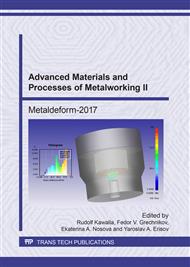[1]
K.A. Christofidou et al. The microstructure and hardness of Ni-Co-Al-Ti-Cr quinary alloys Journal of Alloys and Compounds 688 (2016) 542-552.
DOI: 10.1016/j.jallcom.2016.07.159
Google Scholar
[2]
V.G. Smelov, A.V. Sotov and A.V. Agapovichev, Recovery Technology Features of Aerospace Parts by Layering Synthesis J. Key Engineering Materials 684 (2016) 316-22.
DOI: 10.4028/www.scientific.net/kem.684.316
Google Scholar
[3]
G. Dongdong, H. Beibei, Finite element simulation and experimental investigation of residual stresses in selective laser melted Ti–Ni shapememory alloy Computational Materials Science 117 (2016) 221-232.
DOI: 10.1016/j.commatsci.2016.01.044
Google Scholar
[4]
A.V. Agapovichev, A.V. Balaykin and V.G. Smelov, Production technology of the internal combustion engine crankcase using additive technologies, Modern Applied Science 9 4 (2015) 335-343.
DOI: 10.5539/mas.v9n4p335
Google Scholar
[5]
GOST 11701-84 Metals: Method of tensile testing of thin sheets and strips).
Google Scholar
[6]
R. Ganeriwala, T.I. Zohdi, Multiphysics modeling and simulation of selective laser sintering manufacturing processes, Procedia CIRP 14 (2014) 299 – 304.
DOI: 10.1016/j.procir.2014.03.015
Google Scholar
[7]
G.M. Yuzefovich, Yu. Ya. Vysotsky, Patent No. 2137107 Method of evaluation of material workability.
Google Scholar
[8]
G.M. Yuzefovich, Yu. Ya. Vysotsky, Patent No. 95111755 Method of evaluation of material workability.
Google Scholar
[9]
M.M. Koloskov, E.T. Dolbenko, Yu.V. Kashirsky, et al., Grade Guide for Steels and Alloys, in A.S. Zubchenko (Eds. ), Machine Building Publishers, Moscow, 2001, p.672.
Google Scholar
[10]
Aviation Materials, Vol. 5 «Magnesium and Titanium Alloys», in A.T. Tumanov (Eds. ), ONTI Publishers, Moscow, 1973, p.583.
Google Scholar
[11]
B.N. Arzamasov, I.I. Sidorin, G.F. Kosolapov, et al. Materials Science: Textbook for technical colleges and universities, in B.N. Arzamasov (Eds. ), 2nd Edition. Revised and updated edition, Machine Building Publishers, Moscow, 1986, p.384.
Google Scholar
[12]
A. Bhowmik, H.J. Stone, Microstructure and mechanical properties of two-phase Cr-Cr2Ta alloys, Metall. Mater. Trans. A 43 (2012) 3283-3292.
DOI: 10.1007/s11661-012-1140-6
Google Scholar
[13]
M. Hawryluk, Z. Gronostajki, M. Kaszuba, S. Polak, P. Widomski, J. Ziemba, Analysis of the wear of forging tools surface layer after hybrid surface treatment, International Journal of Machine Tools and Manufacture 114 (2017) 60-71.
DOI: 10.1016/j.ijmachtools.2016.12.010
Google Scholar
[14]
E.A. Lass, M.E. Williams, C.E. Campbell, K. -W. Moon, U.R. Kattner, g0 phase stability and phase equilibrium in ternary Co-Al-W at 900 C, J. Phase Equilib. Diffus. 35 (2014) 711-723.
DOI: 10.1007/s11669-014-0346-2
Google Scholar
[15]
A. Yuksel, M. Cullinan, Modeling of nanoparticle agglomeration and powder bed formation in microscale selective laser sintering systems, Additive Manufacturing 12 (2016) 204-215.
DOI: 10.1016/j.addma.2016.07.002
Google Scholar
[16]
M. Pröbstle, S. Neumeier, P. Feldner, R. Rettig, H.E. Helmer, R.F. Singer, M. Göken, Improved creep strength of nickel-base superalloys by optimized γ/γ' partitioning behavior of solid solution strengthening elements, Materials Science and Engineering A 676 (2016).
DOI: 10.1016/j.msea.2016.08.121
Google Scholar
[17]
Y. Tian, A. Gontcharov, R. Gauvin, P. Lowden, M. Brochu, Effect of heat treatments on microstructure evolution and mechanical properties of blended nickel-based superalloys powders fabricated by laser powder deposition, Materials Science and Engineering A 674 (2016).
DOI: 10.1016/j.msea.2016.07.116
Google Scholar
[18]
Q. Zhang, Y. Chang, L. Gu, Y. Luo, B. Ge, Study of microstructure of nickel-based superalloys at high temperatures, Scripta Materialia 126 (2017) 55-57.
DOI: 10.1016/j.scriptamat.2016.08.013
Google Scholar
[19]
F. Wilhelm, E. Affeldt, E. Fleischmann, U. Glatzel, J. Hammer, Modeling of the deformation behavior of single crystalline Nickel-based superalloys under thermal mechanical loading, International Journal of Fatigue 97 (2017) 1-8.
DOI: 10.1016/j.ijfatigue.2016.12.003
Google Scholar


